Christmas Eve I spent in Lone Elk park, just outside of St. Louis. It’s a large animal preserve and outdoor facility with a 3.2 mile hike around the perimeter. My hiking book described the hike as ‘easy’ but the park labeled it difficult. I side with the park–though the trail was very well marked and in decent shape (meaning no rocks to trip over), there were some pretty stiff climbs.
The park has old buildings left over from World War II and a small, man-made lake in what’s called ‘Elk Hollow’. However, the stars of the park are the animals: the herds of bison, deer, and elk. Especially the elk.
Out walking, I saw a few deer and the geese on the frozen surface of the lake but the only elk I saw were a couple of partially obscured females among the trees. When I got back to the car, though, I saw two young bucks by the side of the road, browsing on the winter dried grass. I grabbed my camera and had just started taking photos when I noticed across the lot in another lot, a mature male with a beautiful rack with the sun reflecting on his gold/brown fur. He was stunning. Absolutely stunning.
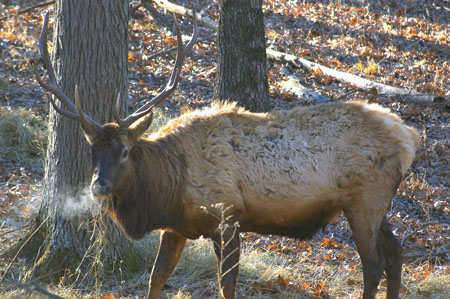
I moved closer to him, but not too close to be a threat, and started taking more photos. After a few minutes of me dancing about, taking shot after shot, he stopped eating and looked at me. He started to step into the parking lot and I backed up to the car, not sure if I had antagonized him. But when I had moved back, he moved back. I moved forward again, and he started moving forward again. We danced back and forth for a few minutes, until I got the point and just stood still. He carefully stepped into the lot, walking in front of the cars that were now stopped to enjoy his (and I have a feeling my) antics.
The other two younger elk followed him toward the lake — keeping an eye on me, but not particularly worried at my presence.
I now have a lot of elk photos. You knew this was coming, didn’t you? I thought that rather than just dump them in the page, I would tell you the story about Tyson Valley, its history, and the reason why the park is called Lone Elk Park. It’s a story of war and peace, and war and peace, again. It’s also a story of perseverance and deep loneliness.
And the atom bomb.
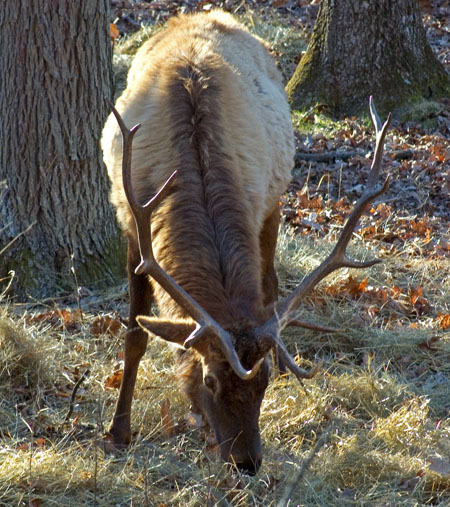
The Lone Elk
No one knows for sure how old the lone elk was; they didn’t even know he still existed, much less the year he was born. When he was finally discovered in the hollow of the old Tyson Valley Powder Farm by the surprised park worker, he was a full grown male.
The park officials guessed he had to be at least seven years old, because elk are dependent on their mothers for their first year; and his mother—along with every other member of his herd—had been rounded up by members of the US Army and shot within a three month period, exactly six years before his discovery.
But I’m getting ahead of my story.
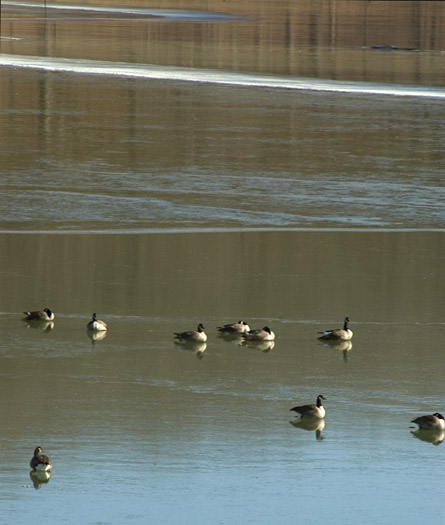
From Peace to War
Tyson Valley is an area framed by the Meramec River and old Route 66, what is now Interstate 44. Prior to the 1940’s, the area was mined. Before Europeans appeared, the native American people would mine the area’s chert deposits, and trade the high quality material with other tribes. After the 1800’s, the area served as a limestone mine and quarry—generating enough business to start a town, which eventually attracted its own railway line. However, the mine played out in 1927, and aside from some lumber operations, the land lay fallow.
All this changed when the US was suddenly drawn into World War II. In 1941, the government bought the land under the concept of eminent domain, purchasing over 2600 acres of hilly country pocketed with the remains of shallow mines. It turned the old town and the rest of the space into the Tyson Valley Powder Farm: an ammunition dump, chemical storage center, and weapon test site. The Army built concrete storage shelters, vaults, and several buildings, in addition to several miles of road. It then enclosed all but a few hundred acres of it with a strong, wire fence. Patrols in jeeps carrying machine guns, or on mules with rifles, rode the parameter keeping intruders out.
There were no elk in the area at that time, and none of the white-tailed deer that are so ubiquitous now. However, even if there were larger animals trapped within the military fence, it’s unlikely that animals would have been allowed among the firing ranges and near the buildings, where the TNT and PETN were stored. They especially wouldn’t be allowed near the building that stored the uranium refined by Mallinckrodt Chemical for the Manhattan Project.
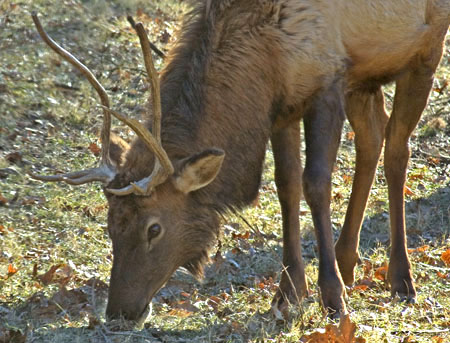
From War to More War
In 1942, several members of the Manhattan Project paid a visit to Edward Mallinckrodt of the Mallinckrodt Chemical Works in St. Louis. They had a problem and wanted to know if he could help them. Their problem was that they needed uranium refined to a higher degree of purity than had ever been produced before.
Following a procedure designed by the University of Chicago, the people at Mallinckrodt were able to meet the needs of the project; the company re-tooled a plant in St. Louis specifically to produce this refined uranium.
Most of the workers had no idea what they were working on.
An operator working for Walter Schmidt read an article in the newspaper about uranium-235–the story was about some work the Austrians were doing at the time. Later that day, as an Army official watched the men work, the man quite innocently asked if the material was similar to U-235. Shocked speechless, the Army man literally ran from the scene and soon returned with three more officials. A barrage of questions followed and they were stunned to learn that the operator had read the very small article and connected it with the work Mallinckrodt was doing.
Not until that day in August, 1945 did the men of Mallinckrodt know how vital their work had been to the winning of the war. A holiday was declared for the people of the uranium project — a brief respite for relaxing and celebrating. Then, on with the job, because there was still much work to do.
Mallinckrodt ended up providing uranium fuel for weapons and for nuclear plants. In the process, due to the contamination of the Weldon Springs area, it also helped create one of St. Louis’ major superfund site (see here).
Once the uranium was refined, it needed to be stored. It had to be stored in an isolated place, with good security and already set up for storing hazardous material. It didn’t take the powers-that-be all that long before turning their eyes to Tyson Valley. From documents released by the DoE, Tyson was used to store refined uranium, consisting of 0.7% u-235, from 1942 to 1947.
Just a few years later when the war was over, the same area that housed uranium was used to house mushrooms.

From War back to Peace
In 1947, at the end of World War II, the government no longer needed the ammo dump and started looking around for a buyer. One of the first and most interested was St. Louis County, which sought to turn the area into a park, with hiking trails and horseback riding. Tyson Valley Park officially opened in 1948, and included among its attractions a miniature railway. It also served as a wildlife refuge, as elk from Yellowstone, Bison from South Dakota, and white-tailed deer from Grant’s Farm were brought in.
The Park thrived, attracting a number of visitors, and the park management made good use of the roads and facilities left by the government. Buildings were turned into restaurants and hot dog stands and shelters were used to store animal feed. Even the concrete storage ‘igloos’ were put to use—leased out to mushroom farmers who found the dark, damp interiors ideal mushroom growing conditions. The animals imported into the park also thrived, and the elk numbers increased. However, Tyson Valley and the animals peaceful existence were short-lived, because following on the heels of World War II, the United States was about to embark on another war, this time with Korea.
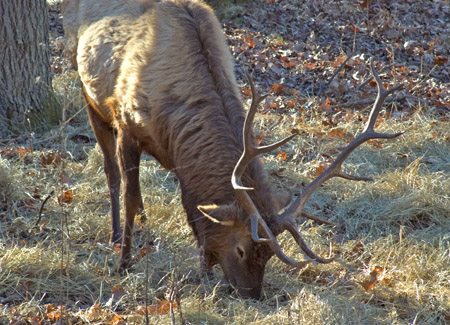
From Peace back to War
In 1951, invoking provisions written into the original contract of sale, the government decided to reinstate the Tyson Valley Powder Farm, and return buildings and the land to their former uses. At first the Army leased the space, but eventually they bought it back from the county–all but a small portion outside of the fence, which ended up becoming West Tyson County Park.
The County tried to find homes for all the animals it brought in, and finally moved the Bison to the zoo at Kansas City. However, no one wanted the elk or the deer so the county left them, where they co-existed for years with the military.
It’s into this environment that the lone elk was born, somewhere in the late 1950’s. By now, the original herd of ten elk had grown, and now numbered 108 members—too many for the area to support. It must have been tough for the little elk and his mother to survive since all the elk were penned within the military fence and they couldn’t migrate to find food. They had to scavenge for what green they could find–even to pulling up grass edging around the ammo dumps and the chemical storage. The scents must have been confusing to the elk: faint shadows of mushroom and hot dogs overlaid by TNT.
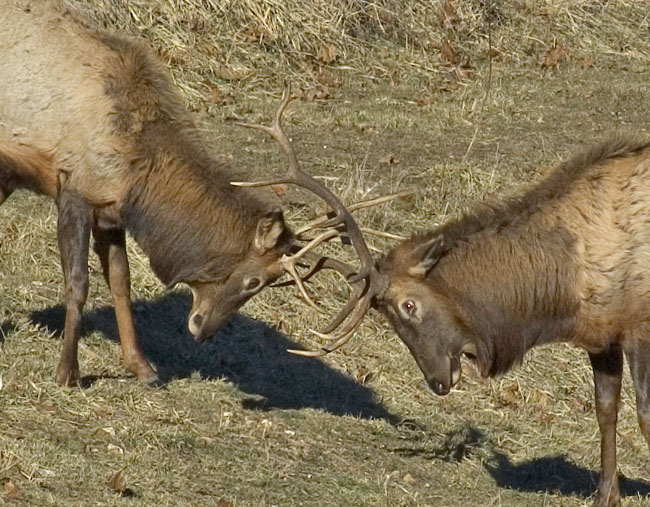
One fall day, a bull elk in the midst of rutting behavior attacked and damaged one of the Army’s cars. An officer at the time decided that the animals were no longer safe to have about — especially since there was now no longer any vegetation for the animals to live on, and the military did not ‘have the funds’ to feed the animals.
The officer gave the order to gather all the elk together and shoot them, donating the meat to the local food pantry. From October 1958 to March 1959, soldiers shot any elk they discovered, until they were gone. They left the deer be, which may have been the saving grace for our young, and now very much alone, elk.
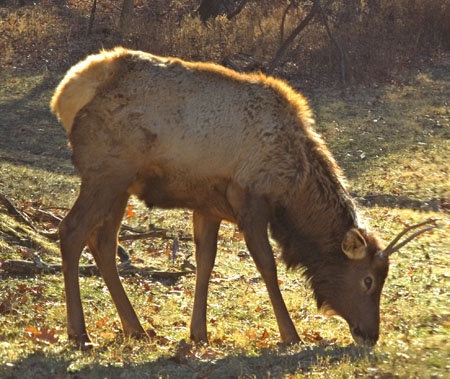
It’s that old peace thing again
The Korean War ended, or faded to an end, which is more realistic. For a while, the land was used by the government for storage of odds and ends, such as the storage of surplus corn and wheat. However, in 1961 the government decided it no longer needed the Tyson Valley Powder Farm and put the land up for sale. The County wanted to re-claim as much land as they could, but Washington University also wanted as much as possible for biological and medical research. The government sold 2000 acres to Washington University, with an odd stipulation that it must conduct research for twenty years. Of the rest, the County was able to buy back an additional 465 acres to add to the West Tyson County Park.
The County had plans to make the park into a winter playground, with skiing and sledding and support for other winter sports. It was while work was underway for both sections of land–the Tyson Research Center and the now expanded Tyson Valley Park, including building fences between the two–that the park worker stumbled on to the large elk, trying to stay hidden in among the trees.
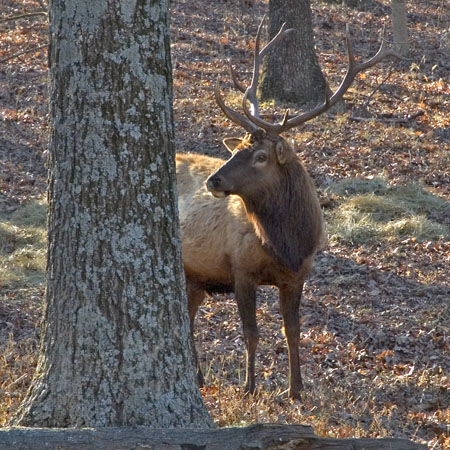
The elk had been hiding for six years (I’ve read reports of ten, but this longer length doesn’t match other records), keeping out of way of any humans, and living off of whatever green it could find in the enclosed area. It’s discovery was to soon change everything. As Conor Watkins wrote:
At the same time, the county was busy constructing a chain-link fence between the park and Washington University’s Tyson Research Center. The park Superintendent, Wayne Kennedy, ordered that a gap be left in the fence until the elk was on the park side of the fence. Kennedy told the park Supervisor, Gene McGillis, to oversee this task. McGillis was an American Indian and familiar with tracking animals. He dumped a truckload of sand at the gap in the fence and waited a few days. When a set of elk tracks was seen entering the park with none leaving, McGillis called Kennedy to have the gap in the fence closed. The gap was closed when Kennedy spotted the elk in the park from a helicopter.
St. Louis County originally planned to turn the hilly park into a winter recreation area with ski slopes, sled and toboggan tracks, camping, and an archery range. Once the elk was in the park, it was decided that the area be used for hiking and picnicking, activities more friendly for an elk. Soon the park was re-named to Lone Elk. The public became involved and students from elementary schools in the Rockwood School District collectively donated $300 to transport more elk from Yellowstone National Park. Students were encouraged to bring dimes to school to help the cause. Any student contributing a dime or more earned a certificate for a share of ‘Elk Stock’. The truckload of elk stopped at Ellisville Elementary and was viewed by exited students. The Fred Weber Corporation donated a $50,000 dam to build a lake within the park. The elk story even gained enough national attention for Walter Cronkite to cover the event.
When the five female and one male elk were brought into the now newly renamed Lone Elk park, the lone elk, formerly so shy, showed up within 20 minutes of their being released. He stayed with the herd until he was found dead a little over a year later.
Speaking of which, does this Story have an Ending
There is no statue to the lone elk, and no burial mound to stand at with bowed head. His story is a testament to the will to survive, and no memorial is more fitting than to take a moment and stand at the banks of the frozen lake in Elk Hollow and watch the geese walk carefully across the ice; or to watch two buck males casually lock antlers, as they work through hierarchy and dominance. Life is, itself, a memorial, and perhaps the only truly worthwhile one at that.
As for Tyson Valley, the marks of war are mostly gone in the park area, though the old Army buildings are still being used in the Tyson Research Center. The government did find buried metal and discarded ammunition in the park, which had to be cleaned up. However, a specially trained medical team from Washington University investigated both the park and the Center and reported in 1988 that they could find no traces of radioactive contamination from the stored uranium.
Who is to say if this is always so, and there was some radioactive contamination in the meat taken from the elks gathered up and hunted? Or in the grain stored for so long, the mushrooms grown in the dark, or the hot dogs served those many years ago?
Most likely not.
However, if there’s ever a blackout in St. Louis and those in Illinois see a dim glow out our way, listen closely and you might hear the faint bugle of a triumphant lone elk in the wind.

